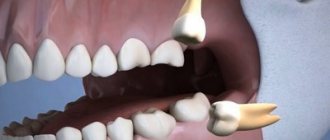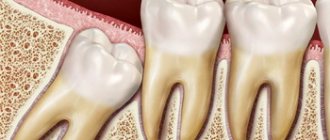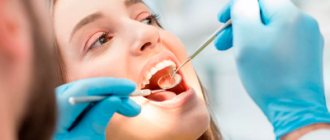For most people, the growth of wisdom teeth is accompanied not only by gum cutting and discomfort, but also by quite severe pain that makes it difficult to eat, concentrate on any task, and even sleep.
If the wisdom tooth grows and does not cause significant discomfort, no medical action may be taken. As a rule, the discomfort goes away after 1-2 weeks, but in order to avoid the manifestation of other problems, it is worth undergoing an examination at a dental clinic. However, if the gums from the wisdom tooth become inflamed, the local and general temperature rises, and specific aching pain is felt, immediately contact your dentist, he will conduct an examination and take the necessary measures to eliminate the problem.
How to know if a wisdom tooth is coming out
A wisdom tooth or “eight” is a third molar that erupts on both sides of both jaws at 16-30 years of age.
Because this age is considered mature, and the third molar is the last one to grow in the jaw, it is called a “wisdom tooth.” Some dentists consider the “eight” to be a vestige, that is, an organ that has lost its significance in the course of evolution. Primitive man needed it to chew rough plant foods - nuts, grains and leaves.
Modern man eats soft food that has undergone culinary processing, so the jaw has become 10-12 cm smaller, and the dental system has been rebuilt. As a result, in 76% of people, the third molar does not erupt, remaining in the bone socket, or grows partially or incorrectly.
From the article on Stom-Firms.ru you will learn how a wisdom tooth grows, why it is difficult for it to erupt and what symptoms arise.
When are third molars removed?
There are a number of reasons why removing “eights” is necessary:
- incorrect direction of the tooth during growth;
- lack of space;
- change in the position of the teeth (crowding);
- strong pressure on the seventh molar;
- process of purulent inflammation;
- crown destroyed by caries.
In some cases, your doctor may advise you not to pull out your molars.
For example, if a patient undergoes dental prosthetics, during eruption they will take the correct position, and the canals are clearly visible for further treatment.
How to understand that a wisdom tooth is cutting?
For many, “eights” erupt without causing complaints. But since the sharp edges of the crown irritate the nerve endings of the gums, the following symptoms occur:
- Soreness or dull throbbing pain;
- Swelling of the gums, which can be felt with the tongue;
- Saliva mixed with blood;
- “Gum hood”, that is, raised gum above the crown of the tooth.
The pain intensifies when a person chews, opens his mouth, or lies down. In people with a low pain threshold, it can be severe, even if the tooth grows correctly and does not encounter obstacles.
If the third molar cannot “break through” the soft tissue, pericoronitis occurs - inflammation of the gum above the crown. The tooth injures the mucous membrane, tears form in it, in which food particles and bacteria accumulate, causing inflammation. Pus forms under the “gum hood” and can be released into the oral cavity.
If pus spreads to the periodontal tissues and bone, periostitis occurs - a flux that causes the following symptoms:
- The mucous membrane becomes cyanotic;
- The cheek is swollen;
- The pain becomes unbearable and intensifies when you try to open your mouth;
- The patient cannot eat;
- The parotid and submandibular lymph nodes are enlarged;
- Body temperature rises to 38°C.
When the swelling spreads to the cheek, palate and throat, the patient experiences difficulty swallowing. Severe pain is disturbing if the “eight” does not fit in the jaw, grows at an angle, or displaces and compresses the neighboring tooth, the “seven”. Because of this, the bite may change, and caries may appear on the neighboring “seven”.
Table of contents
- At what age are eights cut?
- Why is the wisdom tooth called that way?
- How long does it take for a number eight to grow?
- What is a wisdom tooth for?
- When are eights removed?
- Tooth extraction problems
- Is there pain when removing figure eights?
- What measures to take if you have dental problems during pregnancy?
- Complications during the eruption of wisdom teeth
- Actions prohibited for wisdom tooth pain
- What to do if the gums around a wisdom tooth are inflamed
- Is it possible to treat eights with folk remedies?
The eights in human teeth are located at the edges and this is what makes them too problematic. It is worth noting that, unlike other teeth, these grow only many years after the others have appeared, and in some cases the immediate process of their growth causes severe pain and requires their immediate removal. Statistics show the fact that not every person can always have a wisdom tooth, since during the development of the human race significant transformations took place and the jaw of modern people is 12 mm smaller relative to their ancestors, which is caused by eating softer and thermally processed food, which reduces the load on the jaw . Everyone has the germ of a wisdom tooth, but whether they grow or not depends only on physiology.
At what age are eights cut?
The replacement of a row of milk teeth with molars is carried out from 6-12 years. The eruption of wisdom teeth may not begin until the age of 21, but if they have not shown any signs of their existence before the age of 27, then it is quite possible that they will not grow at all. In medical practice, there are cases where a wisdom tooth can erupt at the age of 40, but such cases are very rare.
Why was the wisdom tooth called that way?
As already mentioned, teeth erupt before the age of 7 years, and wisdom teeth in the period 18-27 years. It is at this age that the formation of organs ends and the aging of the body actually begins. In other words, wisdom teeth begin to erupt at a time when the body has reached its maturity, which is how they get their name.
How long does it take for a number eight to grow?
How long the figure eight will grow depends on several factors. Initially, it depends on the size of the jaw a person has, as well as whether there is free space for the tooth to be normally located in its rightful place. If the jaw is too small, and there is simply no additional space for wisdom teeth to grow, then they will begin to gradually move neighboring teeth, which can last for several years, and will also cause a distortion in the evenness of the teeth.
What is a wisdom tooth needed for?
Nature has thought out each organism so carefully that each of its components, and in particular the wisdom tooth, cannot be superfluous. Some experts even call wisdom teeth rudiments, but they are often very useful in old age. It is on wisdom teeth that prosthetic bridges are placed in order to install a dental crown when other chewing teeth are removed. For this reason, dentists do not recommend immediately removing a wisdom tooth, since a banal 2-minute process can cost serious problems in the future.
When are eights removed?
Is it worth it or not to remove a wisdom tooth? This is the question that dentists are often asked by those who have encountered them. Wisdom tooth removal is the most standard surgical procedure, and to perform it, certain indicators are needed. Wisdom tooth removal is quite possible if:
- the presence of ratification of wisdom teeth, or in other words, incorrect placement of the figure eight, which can cause movement of other teeth during eruption;
- damage to wisdom teeth by caries, as this will affect the health of the root system and can affect neighboring teeth, but it is not always possible to fill the figure eight correctly and without mistakes;
- partial eruption of the wisdom tooth, which may occur due to the presence of an inflammatory process in the gum cavity;
- manifestation of pain in the trigeminal nerve;
- detection of a cyst in the cavity of the lower jaw;
- the presence of pain in the wisdom tooth, especially if it occurs when eating food;
- injury to the oral cavity if the wisdom tooth is positioned incorrectly.
Tooth extraction problems
The process of removing tooth 8 in a row can only be carried out by a qualified dental surgeon, after an x-ray. Almost always, tearing out a figure eight is painful, since its location will take a long time to heal and complications may develop. Pain, as a rule, after removal becomes the cause of the formation of alveolitis or, in other words, an inflammatory process in the socket.
Important: Ideally, the hole is covered with blood clots, which prevent the penetration of bacteria and food debris into it, therefore it is strictly forbidden to rinse the mouth after surgery. When washing out clots, you may encounter not just pain, but the formation of an infection, which will require additional surgical intervention and a long-term solution. At first, after the removal of a wisdom tooth, you may feel numbness in the cavity of the tongue, lips and even chin. If the numbness does not subside after a week, then a second visit to the doctor is required.
Is there pain when removing figure eights?
Naturally, tooth extraction is not the easiest or simplest process, and therefore many people are very worried about this and simply avoid meeting with a doctor. The operation is performed using local anesthesia. In other words, a strong painkiller is given, the type of which is discussed individually with the patient. Difficulties may arise when directly removing the figure eight, since the inconvenient location does not allow you to get close and quickly pull it out. Whether there will be severe pain after removal depends on:
- how the tooth is positioned;
- features of the root system;
- whether there are complications such as purulent inflammation, cyst or the like;
- human sensitivity threshold.
What measures should you take if you have dental problems during pregnancy?
Pregnancy is a very difficult and anxious period for every woman, but it is accompanied by a decrease in the level of calcium in the body, which primarily affects the teeth, their quality, strength and wear resistance. It is very important that no woman is immune from the fact that a wisdom tooth may start cutting or hurting.
Important: Gynecologists categorically prohibit dental treatment, regardless of their location, using anesthesia, as this has a detrimental effect on the development of the fetus. If there is a strong need, it is permissible to carry out removal or treatment only after reaching 22 weeks, since it is possible to use painkillers without harm to the baby.
Complications during the eruption of wisdom teeth
Unlike teething other teeth, eights can bring a lot of problems.
The tissue in the gum cavity near the tooth becomes inflamed. This most often manifests itself in the form of a tubercle covered with mucous membrane around the location of the figure eight. This is the so-called hood, which is injured with every meal, irritating the receptors in the mouth and thereby causing severe pain. This contributes to the formation of an inflammatory process and even the occurrence of infection with suppuration.
Sometimes it may seem that there is pain in the cheek, throat and tonsils, but it is the wisdom tooth that spreads these sensations. Only a specialist can identify and diagnose this problem, and therefore a doctor’s consultation is required to rule out the possibility of a cold.
Important: When the figure eight becomes inflamed, the whole body begins to suffer. In other words, the body temperature may rise, pain in the head, throat and even the cervical region may occur. The formation of swelling of the gums is allowed.
Actions prohibited for wisdom tooth pain
Experts do not recommend doing dental treatment on your own, or doing the following:
- warming the cheek, rinsing with hot water and applying a heating pad, as this can lead to a worsening of the condition and the occurrence of suppuration of the inflamed tissue;
- applying painkillers to the inflammation around the figure eight, which contributes to the appearance of ulcers on the tongue cavity, without relieving the pain;
- using advice from relatives, since you first need to find out the cause of pain and inflammation, and only then take measures to eliminate the problem.
What to do if the gums around the wisdom tooth are inflamed?
Intervention in the treatment of wisdom teeth on your own can cause a worsening of the condition, for example, fever, unbearable pain and similar problems. What to do if symptoms associated with the figure eight appear?
- Immediate contact with a dentist is required.
- An x-ray or, preferably, an ultrasound is required.
Important: When making a diagnosis such as the presence of suppuration, regardless of what stage of development, an immediate autopsy is required, as well as treatment and painkillers. Further development depends on the degree of complexity of the problem and on the medical indicators of the patient’s body.
Is it possible to treat eights with folk remedies?
To reduce pain during teething, you can use medications or folk remedies, but only with caution so as not to cause an allergic reaction and other serious consequences.
- The simplest method is considered to be the usual rinsing with a solution based on herbs such as sage, chamomile, oak bark or ordinary soda. It is permissible to lubricate the gums with sea buckthorn oil.
- Melissa officinalis, or to be more precise, a solution based on it is prepared immediately before use and should be stored in the refrigerator. 2 tbsp. pour 0.5 liters of boiling water, infuse for 4 hours and use for rinsing. The procedure is carried out 4 times every 24 hours, after which the composition is brewed again.
- You can boil chicory root and rinse your mouth with it. The peculiarity of the root is the presence of anti-inflammatory and analgesic effects. 250 ml of boiling water should be poured into a container with 1 tbsp. chicory root, previously thoroughly chopped. Boil the composition for 5 minutes. Next, you need to let it brew for 60 minutes, strain and rinse every 2 hours.
Important: If any problems arise with wisdom teeth, for example, pain, swelling, or even more so deformation of the teeth during eruption, you should immediately contact a dentist, a qualified specialist, for examination, consultation and taking certain measures to eliminate the problem.
How long does it take for wisdom teeth to erupt?
The rudiments of “eights” can be detected as early as 3 years. During adolescence, when the jaw is actively growing, roots form. Normally, teething lasts 3-5 months, while unpleasant sensations may disappear and reappear.
The rate of growth depends on both local and general reasons, which we have collected in a table. The listed reasons, on the one hand, slow down eruption, and on the other hand, they disrupt the ratio of the sizes of the jaw and wisdom teeth.
| General factors | Local factors |
|
|
During puberty and pregnancy, the body releases many substances - cell growth factors. They act on G8 stem cells and stimulate its formation and growth.
Molar growth process
With proper growth, figure eight teeth do not cause any particular trouble to the patient. The physiological process ends with the vertical position of the extreme molar, which eliminates changes in bite, caries and the formation of a hood.
The patient may complain only of slight redness and thickening of the gums, mild pain, which can last from several days to a month.
During the eruption of extreme molars, some pathological phenomena may occur.
Most often, these include tooth deviations from vertical growth:
- The process of tilting the molar forward towards the seven is called medial tilt.
The process of tilting the molar forward towards the seven is called medial tilt. It can provoke the onset of caries in a neighboring tooth, the reason for this is constant pressure on the enamel and the accumulation of microorganisms in the gap formed between them.
- With a distal tilt , when the figure eight grows backward, its urgent removal is necessary.
- The eruption of a molar towards the cheek is accompanied by damage to its mucous membrane. The buccal tilt of the tooth can provoke malignant tumors at the site of damage.
- During horizontal and linguistic growth, compression of the roots of sevens , sixes and fives occurs. This causes an inflammatory process that requires immediate removal.
How does a figure eight cut through?
With normal growth of a wisdom tooth, the gum above it becomes loose and soft; after a few days, the lateral chewing tubercles of the crown appear above it, and behind them - its central part with grooves. After complete eruption, the crown is located on the same level as the adjacent one.
Growth anomalies of the figure eight include difficult eruption, retention and dystopia. Let's take a closer look at them.
Difficulty erupting wisdom teeth
The eruption of the third molar may be delayed for several years if there is some obstacle in its path. For example, the lower eights grow more slowly because the mucous membrane over them is thicker than over the upper teeth. In addition to the gum, the crown needs to grow through the fibers of the buccal muscle and the levator pharynx muscle. If during chewing the mucous membrane is constantly injured, scars and seals form in the gum “hood”, the “eight” will not be able to erupt on its own.
Retention of wisdom teeth
During retention, the third molar is formed, but cannot grow through the bone tissue, so it remains or is retained in the bone socket - the periodontal sac. The cause of retention is growths on the periosteum or cementomas in the alveolar sac. Because of them, the “figure eight” fuses with the socket or with the root of an adjacent tooth.
There are 2 types of retention:
- In complete retention, the crown of the third molar is hidden under the bone plate of the jaw, so it cannot be seen or felt. To detect it, the dentist does a targeted x-ray or orthopantomogram.
- More common is incomplete eruption - semi-retention, when part of the crown grows through the gum, and part remains under it.
“Eight” rarely appears in people over 30 years old, because by this age it becomes denser, fuses with the bone socket and cannot completely come out of it. If nothing bothers the patient, the tooth is not touched.
Wisdom tooth dystopia
With dystopia, the figure eight is located outside the dental arch. Depending on the degree of deviation, the following positions are distinguished:
- Vertical, if the tooth deviates slightly from the longitudinal axis of the “seven”;
- Oblique, when the figure eight crown moves towards the cheek, second molar, tongue or palate;
- Horizontal location, if its axis is perpendicular to the axis of the adjacent tooth.
Both growing wisdom teeth and impacted ones can be dystopic. They are displaced if there is not enough space in the jaw or if the rudiment is located incorrectly, for example, not in the bone socket, but in the ascending ramus of the lower jaw.
Where can I get dental care in Orenburg?
If your gums hurt where your wisdom teeth are, you can get qualified dental care in two places: public and private dental clinics. During the appointment, the dentist must:
- Conduct a preliminary examination of the oral cavity, determine the exact cause of the development of painful symptoms;
- If necessary, refer the patient for an x-ray - this procedure is often necessary in the presence of impacted wisdom teeth (completely or partially covered by gum), as well as in the case of surgical removal;
- Take the necessary measures to reduce or eliminate pain and swelling, as well as prevent further aggravation of the situation;
- If necessary, refer to a dental surgeon to remove third molars;
- Provide recommendations for further dental and oral care.
Do your gums hurt and you have symptoms of wisdom tooth growth? Seek qualified help from specialized specialists!
How to relieve pain when wisdom teeth erupt
To reduce pain and swelling, you can massage the gum with your finger or apply a piece of ice to it. Hands must be thoroughly washed and disinfected. The gums need to be massaged gently, in a circular motion; you should not rub too hard, otherwise you can damage it and cause bleeding. Massage is not done if pus is secreted from under the “gum hood”, otherwise the infection can spread to the bone and periodontium.
Ice can be applied up to 5 times a day for a few minutes. The cold causes the tissues to become numb, and the pain decreases for a short time. Peppermint candies also help.
If the gums have become loose and the figure eight has partially erupted, you should:
- Chew on the healthy side so that food does not accidentally fall under the “hood”;
- Avoid hot and spicy foods, which irritate the mucous membranes and increase pain;
- Carefully monitor oral hygiene to prevent pericoronitis;
- Rinse your mouth with antiseptics or infusions of sage and chamomile.
You cannot remove food particles with your fingernail, injure the mucous membrane with a toothbrush, or try to “speed up” tooth eruption with hot compresses.
For severe pain, you can take a painkiller orally or use gels. If the swelling and pain intensify, the body temperature rises, and the third molar does not erupt, contact your dentist. He will examine the oral cavity, take an x-ray and prescribe painkillers and anti-inflammatory drugs. In case of pericoronitis, it is enough to cut off the gingival hood so that the “eight” takes its correct position in the dentition. In difficult cases, the dentist will recommend removing the wisdom tooth.
Possible complications
Inflamed gums cause pain when chewing or swallowing, poor health and fever.
Pericoronitis is one of the serious complications that can occur during the eruption of third molars.
The disease is characterized by an inflammatory process that affects the tissue around the tooth.
Inflamed gums cause pain when chewing or swallowing, poor health and fever.
A characteristic feature of pericoronitis is the abundant proliferation of bacteria under the hood.
Around the third day, the disease becomes purulent. The patient complains of severe toothaches and pain radiating to the ear and temples, painful opening of the mouth.
The presence of pus under the formed hood causes intoxication of the body, which is manifested by high temperature. The patient has severe facial asymmetry on the side of the diseased tooth, pale face and inflammation of the lymph nodes.
Due to the proximity of the figure eight to the second molar, a small gap is formed in which food debris accumulates. The proliferation of bacteria in most cases leads to the appearance of caries.
A tooth that has already come out is considered the most convenient place for bacteria to multiply: its inconvenient location makes them difficult to clean. After some time, the gums become inflamed and swollen. Flux occurs with fever, severe pain and a swollen cheek.
When the upper tooth erupts, the trigeminal nerve may become inflamed, which is manifested by involuntary contraction of the facial muscles and sharp pain. With late therapy, facial paralysis may occur.
An abscess is a purulent disease that causes an unpleasant odor from the mouth, severe throbbing pain, a constant bitter taste and swelling.
Experts' opinion
Numerous clinical studies have proven the therapeutic effect of many products in the Asepta line.
When using the drugs, all patients in the focus group noticed a pronounced analgesic effect. After using the rinses, tissue healing was observed in all patients, and the hygienic condition of the oral cavity improved. The products are recommended for the complex treatment of patients, and their availability and simplicity make it possible to recommend them for the clinical practice of dentists. In addition, according to the results of clinical studies, after 3 weeks of using ASEPTA® rinse, gum bleeding is reduced by 28.3%, inflammation is reduced by 32.3% and the hygienic condition of the oral cavity is improved by 33.5%*.
What complications may arise during horizontal eruption?
- wisdom teeth can contribute to the displacement and tilt of “sevens”, “fives” and “fours” towards the center of the jaw: in this situation they act almost on the principle of braces. True, the effect will not be positive, but negative, because crowding will appear in the frontal zone, and the bite will be disturbed,
- they can destroy the adjacent seventh tooth, its crown and even the bone tissue around it.
Measures for pressure on adjacent teeth
In this case, only anesthetic tablets from your home medicine cabinet will help you get rid of painful sensations at home. Local gels will not help relieve the condition.
If the “sage” threatens the neighboring seventh unit with its incorrect location and growth disturbance, the doctor will recommend its removal. In the case when the process of destruction of the second molar has already started and it is quite significant, the specialist can decide to extract it, and then, perhaps, the “eight” will soon take its place and replace the defect.
Read the article on the topic: “Treatment and removal of wisdom teeth.”
“My wisdom molars are coming in now, three out of four at once. With both of them there are almost no problems, except for a dull pain. But the third one has already managed to cause a mischief; it puts pressure on the neighboring tooth and provokes the development of caries on it. One of these days I’m getting ready to remove it.”
Rimma, review from woman.ru
When pain is normal
When a tooth is cutting and your gums hurt, this condition can be considered normal. The sensations should not be too sharp; they are rather nagging and dull, monotonous, aching.
Do not forget that the tooth began to emerge in adulthood; it did not have a milk predecessor that would have left behind a “beaten path.” The bone tissue of an adult has finally formed, the gums are dense and thick, and it is natural that the third molar injures and damages tissue and touches nerve endings when it passes through them.
How to act in a situation where a tooth grows into the cheek
You need to understand that antiseptics and anesthetic tablets in this case will not help get rid of the problem for a long time; it will have to be solved radically - surgically. Until you remove the tooth, it will constantly injure the mucous membrane, which can lead to the appearance of benign and malignant neoplasms. So be sure to make an appointment with your doctor.
This is interesting! Independent researchers have found that in women, problems with the eruption of third molars, their retention and dystopia, occur twice as often as in men, which is associated with a lack of space on the jaw1.
What folk remedies can relieve the condition?
Traditionally, decoctions of oak bark and chamomile flowers, sage, calendula tincture, and soda-saline solution are used for antibacterial treatment of the oral cavity, eliminating minor pain and signs of inflammation. These products are available to everyone and are safe.
Important! You cannot heat the area where the diseased tooth is located - this can complicate the situation and provoke the spread of bacteria and the inflammatory process to neighboring areas and tissues.
Clinical picture of pericoronitis
The disease begins with increasing pain in the area of the wisdom tooth. The pain is very intense, it can radiate to the temple and ear. Pain may occur when opening the mouth, yawning, or swallowing. Sometimes you feel like your throat and cheek hurt, not your wisdom tooth. The process may also involve the facial muscles and lymph nodes. If a wisdom tooth becomes inflamed, the general condition of the whole body also suffers: a headache occurs and the temperature rises. The mucous membrane in the area of the diseased tooth is painful and red; as a result of “pressure” on the hood, pus may be released and swelling may occur.
At what age do third molars appear?
There are no “eights” in the milk bite. Moreover, their rudiments are not laid during the intrauterine development of the fetus; this process begins only closer to 4-5 years. Crowns are finally formed by 11-12 years, and roots only by 24-26 years. It is believed that around this period they begin to break out. But in practice, situations are common when they appear much later, for example, after 30 years. Or they don’t make their way out at all until the end of life, or they appear only partially (not in full).
Is it possible to speed up the teething time?
No, you won't be able to do this. The process occurs individually for each person and cannot be influenced, but it is necessary to control its development over time. This is best done using dental x-rays.
On a note! If the crown is located close to the surface of the gum and is growing in the right direction, then the doctor may cut the gum to speed up the eruption process. But under no circumstances try to do this yourself using sharp objects! You can introduce an infection inside and cause prolonged bleeding.
Some doctors believe that the optimal eruption time for “eights” is no later than 30 years or no more than one year from the moment of final formation of the root and crown. If this does not happen, then, most likely, they will no longer appear outward, and are more likely to cause various difficulties that we discussed above. Impacted elements can also lead to the formation of cysts, neuralgic pain, osteomyelitis, cellulitis and sepsis.
What to do if the third molar is cut during pregnancy
If a wisdom tooth is cut incorrectly or irregularly during pregnancy, then the first thing a woman needs to do is see a dentist. This process requires close monitoring. The expectant mother cannot undergo surgical manipulations, so the main task is to prevent acute inflammation, which will make it necessary to take drastic measures - to remove the third molar.
To relieve symptoms, a woman can be prescribed antiseptics (for example, Miramistin), rinsing with herbal decoctions, as well as painkillers that are acceptable for the trimester of pregnancy in which she is.
Read about when dental intervention is permissible during pregnancy in the article on the website.
If there is an emergency need to remove a tooth, the doctor must assess all possible risks and conduct a thorough assessment of the health of the expectant mother and child.










